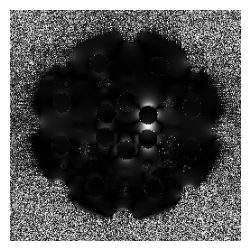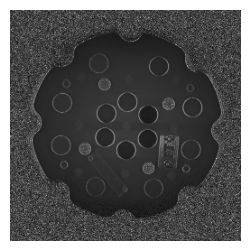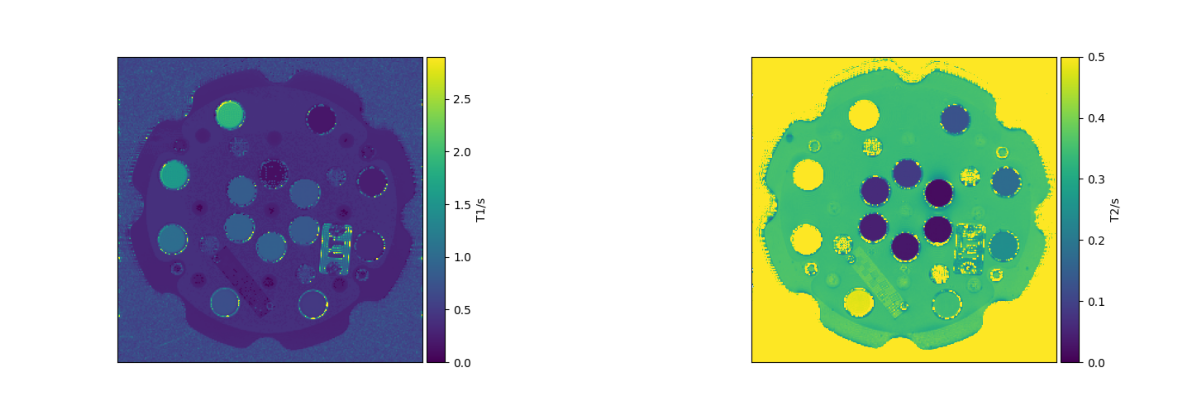
Quantitative Magnetic Resonance Imaging of the NIST Phantom
Heide, Martin $^1$, Scholand, Nick $^2$, Uecker, Martin $^{1,2}$
$^1$ University Medical Center, Göttingen, $^2$ Graz University of Technology, Austria
Subproject B03 - Low-rank and sparsity-based models in Magnetic Resonance Imaging, CRC1456. Magnetic resonance imaging dataset of the T1 layer of the NIST Phantom Model 106 (https://doi.org/10.1002/mrm.28779) acquired with inversion-recovery balanced steady-state free-precession (IR-bSSFP), inversion-recovery fast low angle shot (IR-FLASH) sequences, inversion-recovery single-echo spin echo, single-echo spin echo, gradient echo and FLASH-based B1 mapping sequence with preconditioning RF pulse. The files are intended to be used with the Berkeley Advanced Reconstruction Toolbox (https://doi.org/10.5281/zenodo.592960). Each dataset consists of a ASCII Text-encoded header (.hdr) and a binary-encoded complex float file (.cfl). Data and detailed description of sequence parameters.
The Bloch equation is the model in MRI and describes the behaviour of the net magnetizations $M(p,t)\in\mathbb{R}^3$ of hydrogen proton spins at $p\in\mathbb{R}^3$ under the action of magnetic fields $B(p,t)\in\mathbb{R}^3$ depending on tissue-specific constants $T_1(p),T_2(p) > 0$ for $t\geq t_0\in\mathbb{R}$
$$ \frac{d M(p,t)}{dt} = M(p,t)\times \gamma B(p,t) - \left ( \frac{M_x(p,t)}{T_2(p)}, \frac{M_y(p,t)}{T_2(p)}, \frac{M_z(p,t) -M_z(p,t_0)}{T_1(p)}\right)^T, $$
and $\gamma > 0$ denote the gyromagnetic ratio of hydrogen. The field $B(p,t)$ is composed of various superpositions of the main magnetic field $B_0$, the excitation pulse $B_1$ and gradient field $G$ depending on $t\in\mathbb{R}$. The acquired signal is affected by physical effects like off-resonances or field inhomogeneities of $B_0,B_1$ which are not included in the Bloch model. We present computational results for estimations of $B_0,B_1,T_1,T_2$ from measurements. The measurement sequences used to obtain the data are supposed to compensate for off-resonances and enable one to obtain reproducible results.
exec(open('src/plot_fun.py').read())
plot_all_maps()

Setup of Software and Data
Download and install the latest version of BART
%%bash
rm -rf bart
git clone https://github.com/mrirecon/bart/ bart &> /dev/null
echo "PARALLEL=1" > bart/Makefiles/Makefile.local
cd bart && make &> /dev/null && ./bart version
Download the datasets.
%%bash
rm -rf resources && mkdir resources
wget -q -O resources/data.zip "data.goettingen-research-online.de/api/access/dataset/:persistentId/?persistentId=doi:10.25625/FSLMYU"
unzip -q -o resources/data.zip -d resources
rm -rf reconstructions && mkdir reconstructions
Estimation of $B_0$ field map
%%bash
export PATH=$PWD/bart:$PATH
W=wdir_b0
rm -rf $W && mkdir $W
# estimate coil sensitivity profiles
bart ecalib -c 0 -m 1 resources/data_b0_gre $W/sens
# phase preserving reconstruction
bart pics -e -S -d 0 resources/data_b0_gre $W/sens $W/_reco
SAMPLES=$(bart show -d 0 $W/_reco)
bart resize -c 0 $((SAMPLES/2)) $W/_reco $W/reco
bart slice 5 0 $W/reco $W/te1
bart slice 5 1 $W/reco $W/te2
TE1=0.00492 # Early TE
TE2=0.00738 # Late TE
# Estimate B0 = phase(reco(TE2) * conj(reco(TE2))) / (TE2 - TE1)
# Nayak & Nishimura, MRM, 2000.
bart conj $W/te1 $W/te1c
bart fmac $W/te2 $W/te1c $W/p
bart carg $W/p $W/ph
bart scale -- $(echo $TE1 $TE2 | awk '{printf "%f\n", -1/($2-$1)}') $W/ph reconstructions/b0map
bart flip 1 reconstructions/b0map $W/b0map_t
bart toimg $W/b0map_t figures/b0map
Done.
Writing 1 image(s)...done.
exec(open('src/plot_fun.py').read())
plot_b0map()

2 Estimation of $B_1$ field map
%%bash
export TOOLBOX_PATH=$PWD/bart
export PATH=$TOOLBOX_PATH:$PATH
W=wdir_b1
rm -rf $W && mkdir $W
# B1+ Mapping with Siemens Sequence "tfl_b1map" based on
# Chung, S., Kim, D., Breton, E. and Axel, L. (2010),
# Rapid B1+ mapping using a preconditioning RF pulse with TurboFLASH readout.
# Magn. Reson. Med., 64: 439-446.
# https://doi.org/10.1002/mrm.22423
# Compensate for asymetric echo
## Mirror kspace to fill missing lines
FREQ_ASYM=$(bart show -d 0 resources/data_b1_precond)
PHASE=$(bart show -d 1 resources/data_b1_precond)
DIFF=$(($((PHASE*2))-FREQ_ASYM))
bart extract 0 $((FREQ_ASYM-DIFF)) $FREQ_ASYM resources/data_b1_precond $W/miss
bart flip $(bart bitmask 0) resources/data_b1_precond $W/tmp
bart join 0 $W/tmp $W/miss $W/_raw
bart flip $(bart bitmask 0) $W/_raw $W/raw
# Estimate coil sensitivity profiles
bart ecalib -c 0 -m 1 $W/raw $W/sens
# Phase preserving reconstruction
bart pics -e -S -d 0 $W/raw $W/sens $W/_reco
SAMPLES=$(bart show -d 0 $W/_reco)
bart resize -c 0 $PHASE $W/_reco $W/reco
bart slice 11 0 $W/reco $W/pd
bart slice 11 1 $W/reco $W/pre
bart invert $W/pd $W/pdi
bart fmac $W/pre $W/pdi $W/tmp
# Calculate: arccos(SSPre / PD)
python3 src/arccos.py $W/tmp $W/acos
FA_NOM=80 # [deg] Just from raw data..., IDEA internal... -> vim *.dat and /PrepFlipAngle
# Calculate: kappa = arccos(SSPre / PD) / FA_NOM = b1map
bart scale -- $(echo $FA_NOM | awk '{printf "%f\n", 1/(3.141592653589793 * $1 / 180)}') $W/acos reconstructions/b1map
# visualization
bart flip 1 reconstructions/b1map $W/b1map_t
bart toimg $W/b1map_t figures/b1map
Done.
Writing 1 image(s)...done.
exec(open('src/plot_fun.py').read())
plot_b1map()

3 Estimation of $T_1, T_2$
Under several assumptions, the longitudinal $M_z$ and transverse $M_\mathbb{C}$ solutions to the Bloch equations during the data acquisition read $$ M_\mathbb{C}(p,t) = M_\mathbb{C}(p,t_0) e^{-t/T_2(p)} \ M_z(p,t) = M_\mathbb{C}(p,t_0) (1 - e^{-t/T_2(p)}) $$ and the goal is to fit functions of this type to the measured data in order to obtain the quantitative parameter $T_1(p), T_2(p)$ for each pixel $p$.
%%bash
export TOOLBOX_PATH=$PWD/bart
export PATH=$TOOLBOX_PATH:$PATH
W=wdir_t1t2
rm -rf $W && mkdir $W
# Coil-wise reconstruct the dataset and coil-combine to a single dataset
bart fft -i 7 resources/data_GSM_t1 $W/tmp
bart resize -c 0 256 1 256 $W/tmp $W/reco
bart rss 8 $W/reco reconstructions/recoTI
# Coil-wise reconstruct the dataset and coil-combine to a single dataset
bart fft -i 7 resources/data_GSM_t2 $W/tmp
bart resize -c 0 256 1 256 $W/tmp $W/reco
bart rss 8 $W/reco reconstructions/recoTE
# Put echo times in milliseconds in file and convert to seconds
bart vec 12 20 30 40 70 100 150 200 250 350 $W/T2enc0
bart transpose 0 5 $W/T2enc0 $W/T2enc1
bart scale -- 0.001 $W/T2enc1 $W/T2enc
# Fit Model to data acquired at echo times
bart mobafit -T $W/T2enc reconstructions/recoTE $W/fit
# slice out relevant quantitative parameter
bart slice 6 1 $W/fit $W/mapR2
# compute T1 = 1/R2
bart invert $W/mapR2 reconstructions/mapT2
python3 src/t1_fit.py reconstructions/recoTI "35 75 100 125 150 250 1000 1500 2000 3000" $W/IRfit
bart slice 2 1 $W/IRfit reconstructions/mapT1
# visualize estimated parameter maps and masks
python3 src/createqplot.py reconstructions/mapT2 0 0.5 "T2/s" figures/t2map.png
python3 src/createqplot.py reconstructions/mapT1 0 2.9 "T1/s" figures/t1map.png
exec(open('src/plot_fun.py').read())
plot_qmaps()

4 Advanced estimation of $T_1$: The Look-Locker Model
More advanced method of estimating $T_1$.
%%bash
export TOOLBOX_PATH=$PWD/bart
export PATH=$TOOLBOX_PATH:$PATH
W=wdir_looklocker
rm -rf $W && mkdir $W
NPOINTS=$(bart show -d 0 resources/data_irflash)
ANGLE=7
NSPOKES=$(bart show -d 10 resources/data_irflash)
#echo $(bart show -d 1 resources/data_irflash)
#M=$(($(bart show -d 0 resources/data_irflash)/2))
#echo $NPOINTS
#echo $NSPOKES
# The data was acquired with 18 receiver coils. In order to reduce computational costs, compression to five coils is applied
bart cc -p 5 -A resources/data_irflash $W/k0
bart transpose 1 2 $W/k0 $W/k1
bart transpose 0 1 $W/k1 $W/k2
# create radial sampling trajectories with angle ANGLE between consecutive spokes
bart traj -x $NPOINTS -y 1 -s $ANGLE -c -G -t $NSPOKES -D -r $W/traj0
# we want to correct for gradient delays with RING (measurement imperfection: The sampled data belongs actually to slightly shifted trajectories)
# for gradient delay estimation we take data on 150 spokes
bart extract 10 $((NSPOKES-150)) $NSPOKES resources/data_irflash $W/d0
bart extract 10 $((NSPOKES-150)) $NSPOKES $W/traj0 $W/traj1
bart transpose 2 10 $W/d0 $W/d1
bart transpose 2 10 $W/traj1 $W/traj2
bart flip 4 $W/d1 $W/d2
bart flip 4 $W/traj2 $W/traj3
#bart traj -x $NPOINTS -y 1 -s $ANGLE -c -G -t $NSPOKES -D -r -O -q $(bart estdelay $W/traj3 $W/d2) $W/traj4
%%bash
# gitlab pipeline complains about exceeding artifact size, so we delete some data
rm -rf resources
rm -rf reconstructions
rm -rf wdir_b0
rm -rf wdir_b1
rm -rf wdir_t1t2
rm -rf wdir_looklocker



